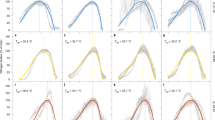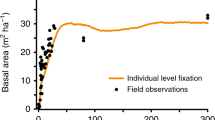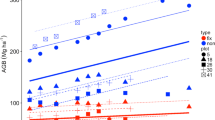Abstract
Nitrogen limits primary production in almost every biome on Earth1,2. Symbiotic nitrogen fixation, conducted by certain angiosperms and their endosymbiotic bacteria, is the largest potential natural source of new nitrogen into the biosphere3, influencing global primary production, carbon sequestration and element cycling. Because symbiotic nitrogen fixation represents an alternative to soil nitrogen uptake, much of the work on symbiotic nitrogen fixation regulation has focused on soil nitrogen availability4,5,6,7,8. However, because symbiotic nitrogen fixation is an energetically expensive process9, light availability to the plant may also regulate symbiotic nitrogen fixation rates10,11. Despite the importance of symbiotic nitrogen fixation to biosphere functioning, the environmental factors that most strongly regulate this process remain unresolved. Here we show that light regulates symbiotic nitrogen fixation more strongly than does soil nitrogen and that light mediates the response of symbiotic nitrogen fixation to soil nitrogen availability. In a shadehouse experiment, low light levels (comparable with forest understories) completely shut down symbiotic nitrogen fixation, whereas soil nitrogen levels that far exceeded plant demand did not fully downregulate symbiotic nitrogen fixation at high light. For in situ forest seedlings, light was a notable predictor of symbiotic nitrogen fixation activity, but soil-extractable nitrogen was not. Light as a primary regulator of symbiotic nitrogen fixation is a departure from decades of focus on soil nitrogen availability. This shift in our understanding of symbiotic nitrogen fixation regulation can resolve a long-standing biogeochemical paradox12, and it will improve our ability to predict how symbiotic nitrogen fixation will fuel the global forest carbon sink and respond to human alteration of the global nitrogen cycle.
This is a preview of subscription content, access via your institution
Access options
Access Nature and 54 other Nature Portfolio journals
Get Nature+, our best-value online-access subscription
$29.99 / 30 days
cancel any time
Subscribe to this journal
Receive 12 digital issues and online access to articles
$119.00 per year
only $9.92 per issue
Buy this article
- Purchase on Springer Link
- Instant access to full article PDF
Prices may be subject to local taxes which are calculated during checkout




Similar content being viewed by others
References
LeBauer, D. & Treseder, K. Nitrogen limitation of net primary productivity in terrestrial ecosystems is globally distributed. Ecology 89, 371–379 (2008).
Elser, J. J. et al. Global analysis of nitrogen and phosphorus limitation of primary producers in freshwater, marine and terrestrial ecosystems. Ecol. Lett. 10, 1135–1142 (2007).
Chapin, F. III, Matson, P. & Vitousek, P. Principles of Terrestrial Ecosystem Ecology (Springer, New York, NY, 2011).
Vitousek, P. & Howarth, R. Nitrogen limitation on land and in the sea: how can it occur? Biogeochemistry 13, 87–115 (1991).
Menge, D. N. L., Wolf, A. A. & Funk, J. L. Diversity of nitrogen fixation strategies in Mediterranean legumes. Nat. Plants 1, 15064 (2015).
Barron, A. R., Purves, D. W. & Hedin, L. O. Facultative nitrogen fixation by canopy legumes in a lowland tropical forest. Oecologia 165, 511–520 (2011).
Batterman, S. A. et al. Key role of symbiotic dinitrogen fixation in tropical forest secondary succession. Nature 502, 224–227 (2013).
Batterman, S. A., Wurzburger, N. & Hedin, L. O. Nitrogen and phosphorus interact to control tropical symbiotic N2 fixation: a test in Inga punctata. J. Ecol. 101, 1400–1408 (2013).
Gutschick, V. Evolved strategies in nitrogen acquisition by plants. Am. Nat. 118, 607–637 (1981).
Rastetter, E., Vitousek, P. & Field, C. Resource optimization and symbiotic nitrogen fixation. Ecosystems 4, 369–388 (2001).
Vitousek, P. & Field, C. Ecosystem constraints to symbiotic nitrogen fixers: a simple model and its implications. Biogeochemistry 46, 179–202 (1999).
Hedin, L. O., Brookshire, E. N. J., Menge, D. N. L. & Barron, A. R. The nitrogen paradox in tropical forest ecosystems. Annu. Rev. Ecol. Evol. Syst. 40, 613–635 (2009).
Crews, T. E. Phosphorus regulation of nitrogen fixation in a traditional Mexican agroecosystem. Biogeochemistry 21, 141–166 (1993).
Wurzburger, N. & Miniat, C. F. Drought enhances symbiotic dinitrogen fixation and competitive ability of a temperate forest tree. Oecologia 174, 1117–1126 (2014).
Houlton, B. Z., Wang, Y.-P., Vitousek, P. M. & Field, C. B. A unifying framework for dinitrogen fixation in the terrestrial biosphere. Nature 454, 327–330 (2008).
Murphy, P. M. Effect of light and atmospheric carbon dioxide concentration on nitrogen fixation by herbage legumes. Plant Soil 95, 399–409 (1986).
MacDowall, F. D. H. Effects of light intensity and CO2 concentration on the kinetics of 1st month growth and nitrogen fixation of alfalfa. Can. J. Bot. 61, 731–740 (1982).
Lau, J. A. et al. Direct and interactive effects of light and nutrients on the legume-rhizobia mutualism. Acta Oecol. 39, 80–86 (2012).
McHargue, L. A. Factors Affecting the Nodulation and Growth of Tropical Woody Legume Seedlings (Florida International University, Miami, FL, 1999).
Myster, R. W. Light and nutrient effects on growth and allocation of Inga vera (Leguminosae), a successional tree of Puerto Rico. Can. J. For. Res. 36, 1121–1128 (2006).
Sprent, J. I. Growth and nitrogen fixation in Lupinus arboreus as affected by shading and water supply. New Phytol. 72, 1005–1022 (1973).
Oberbauer, S. F., & Strain, B. R. Effects of light regime on the growth and physiology of Pentaclethra macroloba (Mimosaceae) in Costa Rica. J. Trop. Ecol. 1, 303–320 (1985).
Vitousek, P. M. & Matson, P. A. Nitrogen transformations in a range of tropical forest soils. Soil Biol. Biochem. 20, 361–367 (1988).
Chou, C. B., Hedin, L. O. & Pacala, S. W. Functional groups, species and light interact with nutrient limitation during tropical rainforest sapling bottleneck. J. Ecol. 106, 157–167 (2018).
Chazdon, R. L. & Pearcy, R. W. The importance of sunflecks for forest understory plants. Bioscience 41, 760–766 (1991).
Pons, T. L., Perreijn, K., van Kessel, C. & Werger, M. J. A. Symbiotic nitrogen fixation in a tropical rainforest: 15N natural abundance measurements supported by experimental isotopic enrichment. New Phytol. 173, 154–167 (2007).
Menge, D. N. L., Levin, S. A. & Hedin, L. O. Facultative versus obligate nitrogen fixation strategies and their ecosystem consequences. Am. Nat. 174, 465–477 (2009).
Menge, D. N. L. et al. Why are nitrogen-fixing trees rare at higher compared to lower latitudes? Ecology 98, 3127–3140 (2017).
Brookshire, E. N. J., Gerber, S., Menge, D. N. L. & Hedin, L. O. Large losses of inorganic nitrogen from tropical rainforests suggest a lack of nitrogen limitation. Ecol. Lett. 15, 9–16 (2012).
Liang, S. et al. Global LAnd Surface Satellite (GLASS) Products (Springer, New York, NY, 2014).
Sollins, P., Sancho, M. F., Mata, C. R. & Sanford, R. L. in La Selva: Ecology and Natural History of a Neotropical Rain Forest (ed McDade, L.) Ch. 4 (University of Chicago Press: Chicago, IL, 1994).
Flores, E. M. in Tropical Tree Seed Manual: Agricultural Handbook (Academia Nacional de Ciencias de Costa Rica, San Jose, 2002).
Lieberman, D. & Lieberman, M. Forest tree growth and dynamics at La Selva, Costa Rica (1969–1982). J. Trop. Ecol. 3, 347–358 (1987).
Joker, D. & Salazar, R. Pentaclethra macroloba. Seed Leafl. 35, 1–3 (2000).
Brady, N. C. & Weil, R. R. The Nature and Properties of Soils (Prentice Hall, Upper Saddle River, NJ, 2002).
Chalk, P. M. Estimation of N2 fixation by isotope dilution: an appraisal of techniques involving 15N enrichment and their application. Soil Biol. Biochem. 17, 389–410 (1985).
Reed, S. C., Cleveland, C. C. & Townsend, A. R. Functional ecology of free-living nitrogen fixation: a contemporary perspective. Annu. Rev. Ecol. Evol. Syst. 42, 489–512 (2011).
Russell, A. E. & Raich, J. W. Rapidly growing tropical trees mobilize remarkable amounts of nitrogen, in ways that differ surprisingly among species. Proc. Natl Acad. Sci. USA 109, 10398–10402 (2012).
Phillips, D. & Gregg, J. Uncertainty in source partitioning using stable isotopes. Oecologia 127, 171–179 (2001).
Anderson, D. R. Model Based Inference in the Life Sciences: A Primer on Evidence (Springer, New York, NY, 2008).
Chazdon, R. L. et al. Rates of change in tree communities of secondary Neotropical forests following major disturbances. Philos. T. Roy. Soc. B 362, 273–289 (2007).
Menge, D. N. L. & Chazdon, R. L. Higher survival drives the success of nitrogen-fixing trees through succession in Costa Rican rainforests. New Phytol. 209, 965–977 (2016).
Taylor,B. N., Chazdon, R. L., Bachelot, B. & Menge, D. N. L. Nitrogen-fixing trees inhibit growth of regenerating Costa Rican rainforests. Proc. Natl Acad. Sci. USA 114, 8817–8822 (2017).
Tian, L. & Wu, J. Confidence intervals for the mean of lognormal data with excess zeros. Biometrical J. 48, 149–156 (2006).
Bolker, B. M. & R Development Core Team. bbmle: tools for general maximum likelihood estimation. https://cran.r-project.org/package=bbmle (2017).
R Core Team. R: A language and environment for statistical computing. http://www.r-project.org/ (2017).
Acknowledgements
The authors thank E. Salicetti, M. Wilcots, R. Li, S. Taylor, B. Scott, E. Utset, B. Matarrita, D. Madrigal and O. Vargas for help conducting the experiment, and collecting and processing samples. This work was supported by the Garden Club of America’s Award in Tropical Botany, Columbia University’s Earth Institute and the Institute for Latin American Studies.
Author information
Authors and Affiliations
Contributions
B.N.T. designed and implemented the study, analysed data and wrote the first draft. D.N.L.M. designed the study, analysed data and revised the manuscript.
Corresponding author
Ethics declarations
Competing interests
The authors declare no competing interests.
Additional information
Publisher’s note: Springer Nature remains neutral with regard to jurisdictional claims in published maps and institutional affiliations.
Supplementary information
Supplementary Information
Supplementary Figure 1 and Supplementary Tables 1–3.
Rights and permissions
About this article
Cite this article
Taylor, B.N., Menge, D.N.L. Light regulates tropical symbiotic nitrogen fixation more strongly than soil nitrogen. Nature Plants 4, 655–661 (2018). https://doi.org/10.1038/s41477-018-0231-9
Received:
Accepted:
Published:
Issue Date:
DOI: https://doi.org/10.1038/s41477-018-0231-9
This article is cited by
-
Soil nitrogen forms and their coupling relationships during the growing season of a Larix principis-rupprechtii plantation at different growth stages and stand densities
New Forests (2024)
-
Nitrogen and light regulate symbiotic nitrogen fixation by a temperate forest tree
Oecologia (2023)
-
Can we see the nitrate from the trees? Long-term linkages between tropical forest productivity and stream nitrogen concentrations
Biogeochemistry (2023)
-
Biochar application increases biological nitrogen fixation in soybean with improved soil properties in an Ultisol
Journal of Soil Science and Plant Nutrition (2023)
-
Herbivores drive scarcity of some nitrogen-fixing tropical trees
Nature (2022)



